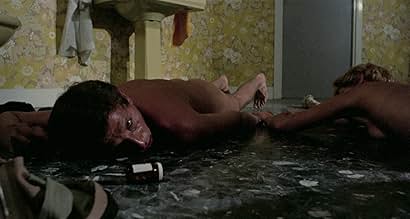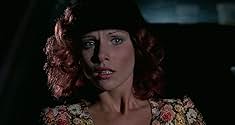Adicionar um enredo no seu idiomaA young pathology doctor interning in a morgue tries to cope with a wave of suicides. A woman she just met kills herself, but she suspects someone close to her might have killed her.A young pathology doctor interning in a morgue tries to cope with a wave of suicides. A woman she just met kills herself, but she suspects someone close to her might have killed her.A young pathology doctor interning in a morgue tries to cope with a wave of suicides. A woman she just met kills herself, but she suspects someone close to her might have killed her.
- Direção
- Roteiristas
- Artistas
- Archivist at Criminal Museum
- (as Piero Anchisi)
- Man in Restaurant
- (não creditado)
- Car Race Spectator
- (não creditado)
- Direção
- Roteiristas
- Elenco e equipe completos
- Produção, bilheteria e muito mais no IMDbPro
Avaliações em destaque
Lovely Mimsy Farmer is a pathology student in Rome puzzling over a succession of suicides, partly because she's doing a thesis on natural vs. faked suicides. Could these people really be killing themselves, or is a murderer at work? Simona (Farmer) works with a young race car driver turned priest, Paul Lenox (the under-rated veteran character actor Barry Primus) to determine the truth. One of these deaths was that of Lenox's sister, and he's convinced she had to have been killed by someone else.
This is never too hard to follow, and it's got at least one appreciably unique gimmick going for it: sunspots, it's theorized, could be inducing some sort of mass psychosis in the minds of the victims. The story is populated with entertaining characters, including Simona's father (Carlo Cattaneo), his romantic partner (Angela Goodwin), and Simona's friend Edgar, played by the handsome Ray Lovelock whom fans of foreign horror will recognize from "Let Sleeping Corpses Lie" and "Last House on the Beach".
Enriched by an Ennio Morricone music score that's equal parts beautiful and spooky, "Autopsy" is more straightforward than some Giallo fans may expect, although it still finds the time to feature some truly hideous, hallucinatory imagery. Use of locations is a plus, as are the performances. Mimsy is appealing and believably vulnerable, Primus is appropriately intense, and Lovelock is amusing to watch every time he's on screen. Credit is due to co-writer and director Armando Crispino, who reels us in immediately with a grabber of an opening.
All in all, this is good stuff; it might not be trashy enough for some lovers of the Giallo genre, but it entertains solidly and stays on track up to its grim finish.
Seven out of 10.
"Autopsy" features many frightening and often bizarre sequences, a quite complex plot and elaborate characters. The storyline is sometimes quite complex to follow, especially since the scene changes often seem quite abrupt, but this only makes the film less predictable, and everything makes perfect sense as a whole. The performances are entirely very good. Mimsy Farmer is excellent in the lead, and portrays her character's fears and nightmares in a very believable manner. Another great performance is delivered by Barry Primus, who plays a quite unusual catholic priest. The cast furthermore includes Ray Lovelock, a regular to Italian genre cinema, and Ernesto Colli, who should be known to Italian Horror buffs for his role in Sergio Martino's 1973 giallo masterpiece "Torso" (aka. "I Corpi presentano tracce di violenzia carnale"). It should be said that "Autopsy" is not the gore-fest the DVD cover might make you think. Even though there are some very violent sequences and many repulsive images, the violence is quite tame compared to many other Gialli of the mid 70s. The movie's main intention is suspense and it definitely succeeds in being suspenseful. "Autopsy" is a stylish, atmospheric and very suspenseful Giallo, that no lover of Italian Horror should allow himself to miss. Highly Recommended!
We're given the idea that something like sunspots and flares are the force behind a sudden wave of suicides and that, along with exhaustion, are why medical examiner Mimsy Farmer is having hallucinations of corpses in the hospital coming to life and taunting her. Apparently this same sun problem is what sets off a killer to start killing people (that Mimsy happens to know) and making it look as if these killings were actually just another suicide. As it turns out he does have a motive, but this sun/suicide bit cand throw you. Like many giallos, there is an obligatory explanation at the climax that flashes back to a traumatic experience the killer had as a child (this kind of thing also happened in Don't Torture A Duckling, aka "Non si sevizia un paperino" and Torso, aka "I Corpi presentano tracce di violenza carnale").
It actually took a second viewing for me to understand the sun thing, the suicides, and the killings and put it all together--this film has so much going on that there are many distractions particularly of a sexual nature, you are drawn this way and that which is why connecting the plot points gets difficult at times. Is that a good thing? Well, this film doesn't hold back and has a generous amount nudity, even full frontal. There is a scene where Ray Lovelock shows Mimsy a slide show of "vintage" erotic photographs that, in two of the quickly passing close-up photos you'll find yourself saying "oh man, was that actually what I THOUGHT I saw?" and while not really pornographic will nonetheless surprise you since this film was made in 1973. Two sexual interludes (interrupted as they are) also add to the "this is getting gratuitous" element and an art gallery featuring photos of human torture are also present (I found these particular photos shocking and I thought I was jaded to these kinds of things). It wasn't difficult for me to see what was cut for domestic release in the states--this film packs a visual punch and just keeps going.
All in all, I am glad I have this film as part of my collection because it is a curiosity that really can't be ignored. Call it a guilty pleasure if you will. After understanding it from the second viewing, I started looking deeper into Autopsy and realizing it has its own personality and more of a story to offer than, say, the basic "let's get women naked then kill them" mood of Torso. While Mimsy Farmer is a little difficult to warm up to with her once nice then cold moods, her part is played competent enough we still hope she gets through the ordeal. Barry Primus behaves like one of those people you hope doesn't sit next to you on the bus--a bit on edge and prone to bursts of anger. Ray Lovelock is always interesting to see, particularly because of the choice of dubbing for his part--I'm wondering if some day I'll get to hear his actual voice in a film! He also conveys an early 1970's example of the masculine and sexual leading guy: bearded and real, instead of the cookie cutter cutie boys put in lead roles in films these days.
Anchor Bay gets points for taking these Italian gems and getting them restored so well that the picture looks better than most Hollywood film transfers. Some audio portions of Autopsy were not recorded in English, so a couple brief scenes are in Italian with English subtitles. An unusual move, but I appreciate the fact that at least the film is intact. One scene involving a newspaper headline and discussion of the sun is a key scene for the plot, and was one that was cut in American distribution because it wasn't recorded in English. Now that it's back in, it really makes a difference.
Autopsy is not a perfect film, not a bad film, basically one of those films that manage to grab your attention at any cost. For collectors of 1970s Italian giallos it has merit, for other folk, well, be prepared--you'll be raising your eyebrows so much your face will hurt by the ending!!
Whilst the initial scenes imply something almost supernatural (corpse copulation?), this well paced little shocker quickly finds its familiar Giallo groove as morgue physician Farmer begins to emotionally unravel under the pressures of documenting a burgeoning spate of apparent suicides. Anglo-Italian Lovelock is Farmer's care-free (and somewhat perverted) BF, whilst fellow Americano Barry Primus plays a priest with a tumultuous past. Special mention too for Ernesto Colli as a creepy morgue attendant and Angela Goodwin and her wicked sense of dark humour.
Like most of its ilk, the real story doesn't emerge for some time and the characters flirt with danger as they get closer to the culprit; there's also enough nudity to make a peeping Tom blush, and some occasional gore (which you'd expect in a movie entitled "Autopsy" though as aforesaid, it's not a butcher's shop nor meat market for gore).
The title is likely to offend most punters, which is a shame because it's not a bad movie, probably attracting an unwarranted notoriety it doesn't deserve. But that's their loss - if you enjoy Giallo, you should be quite satisfied with this offering (which despite various published release dates, appears to have been made in 1973 according to the opening titles).
Você sabia?
- CuriosidadesThe American death metal band Autopsy decided to name their group after the film because of how much they liked it. According to the band's frontman, Chris Reifert, it is one of his all-time favorite horror movies.
- Erros de gravaçãoWhen Simona raises her hands to push off an overamorous apparition, when it disappears, her hands are higher than they should be, relative to where they had been pushing off the incorporeal corpse.
- Citações
Father Paul Lenox: I kill you, i've already killed a lot of people. You understand, YOU UNDERSTAND. I'll kill you too. I'll kill you, i'll kill you, i'll kill you, i'll kill you, i'll kill you.
- Versões alternativasThe version released by Anchor Bay is the complete and uncut 100-minute version, which restores over 15 minutes of footage that was deleted for the film's original American release.
- ConexõesFeatured in Invasion of the Scream Queens (1992)
Principais escolhas
- How long is Autopsy?Fornecido pela Alexa
Detalhes
Contribua para esta página





























